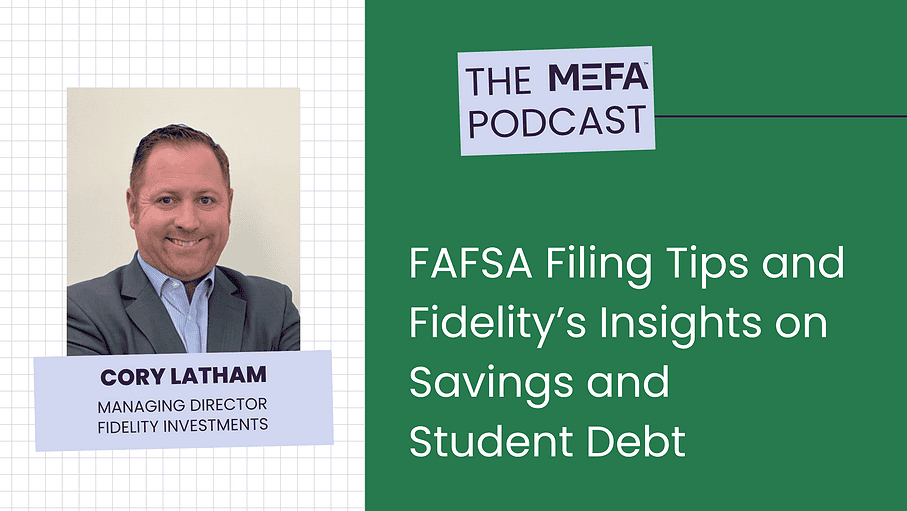Resources Mentioned in this Episode
Cory Latham: [00:00:00] What I’ll talk a little bit about is the apprenticeships, vocational technical schools. So since 2021, we’ve seen a three times increase in the amount of students who say they’re most likely. Consider that-
Jonathan Hughes: A three- three times.
Cory Latham: Three times, yes.
Jonathan Hughes: Wow.
Cory Latham: Now that’s from 2% to 6%.
So it’s still a smaller percentage, but three times is a pretty big jump. Yeah. To saying that they’re most likely to consider it. So I think what it comes into is it’s a combination of the enhancements with the. 5 29 plans do allow for this. And I’ll touch on it again. Students are really being practical. I think there’s so much more knowledge and education of what the cost of college is. Not only what we’re going to pay during those years that we’re in it, but what is it going to mean for me after as students are being more practical.
Jonathan Hughes: Hi everyone and [00:01:00] welcome to the MEFA Podcast. My name is Jonathan Hughes.
Julie Shields-Rutyna: And I’m Julie Shields-Rutyna.
Jonathan Hughes: That’s right. Julie’s back. How are you, Julie?
Julie Shields-Rutyna: Hi, Jonathan. I’m doing well.
Jonathan Hughes: It is great to have you. It’s been a long time.
Julie Shields-Rutyna: I love this, so that’s great.
Jonathan Hughes: I know. It’s my fault. There’s going to be more Julie episodes coming up, I promise.
I promise. A little bit later on in the show, you’ll hear from Corey Latham from Fidelity Investments, and he’s going to tell us about college savings because this is September. We’re recording this in September, which is college savings. Month. So he’s back with us this week. Fidelity, of course, is the program manager for me a’s new fund, the Massachusetts 5 29 plan.
And on our last episode, Cory was on and talked about all of the new expansions, all the new things that you can use five 20 nines for and that we’re all really excited about. And today he’s going to tell us about a research project that Fidelity did there. Sa Higher Education Savings [00:02:00] survey and what that tells us about how Americans.
Parents and students feel about saving and paying for higher education, how they’re doing, saving for college and for higher ed in general and how they save. I always say that the most frequent question I get from parents is, how do people do this? So they want to know how other folks are paying for higher ed.
So if you want to know how your friends and neighbors are doing this and how they’re feeling about saving for. Higher education. You want to make sure to listen to this conversation, but September is not only college savings month, it’s the month before the FAFSA comes out, right Julie?
Julie Shields-Rutyna: It sure is. It sure is. The FAFSA for 26-27. So that is the year that a student will be starting college 2026 next year. That FAFSA for current high school seniors. And everyone else will be attending next fall will be [00:03:00] launched on October 1st. So that’s coming right up.
Jonathan Hughes: Yeah. So we thought we would just take this opportunity to tell folks how they can get ready to file the FAFSA once it is available. So how you can tee up your FAFSA and be ready to go. And Julie, what is our first tip?
Julie Shields-Rutyna: Yeah I guess the first tip to be ready is to figure out who needs to file the FAFSA. So that should be pretty, pretty easy because it’s always the student. So the student needs to file the fafsa. And then there are usually other people who need to file the FAFSA with them, and they call those people the contributors. So those are other people who are going to add their income and assets to the form. So who counts as a contributor will differ from family to family. That’s what we mean by figuring out who’s going to file the form.
Jonathan Hughes: Yeah. So to back up one step, you said most people probably [00:04:00] will need, most students will need other folks parents to put their information down on the FAFSA. Who will need that and who won’t need that?
Julie Shields-Rutyna: Yeah. If you are a dependent, that’s another financial aid word dependent student then you do need. Parents information on the FAFSA, and if you are independent, you’re just, you can just put your own information on the FAFSA, but as we’ll talk about those terms aren’t what you feel like you are dependent, independent. There are serious terms.
Jonathan Hughes: Yeah. So how do you know which one you are then?
Julie Shields-Rutyna: Yeah. Really to most students who are coming out of high school, going into college are going to be considered dependent. So it’s a very strictly defined. Term. Okay. There are a series of questions that the student gets when they start the FAFSA.
And that will determine whether they are [00:05:00] dependent or independent. So I won’t go through all of them, but this is the gist of the type of questions that the student will see. It will ask the student, are you a graduate student? Will you be 24 years of age when school begins? Are you married? Do you have dependents that you support more than 50% of the time?
So these are the type of questions that if the answer is yes to those, that would make the student independent. But again, most students leaving high school going into college will be answering no. To those questions, so they will be considered dependent. I will make one point though that if a student is in a legal guardianship, then they can be treated as independent and don’t need to list the legal guardian’s income and assets. They would only, students only have to list parents income and assets.
Jonathan Hughes: Okay. So let’s assume for the most part that we’re dealing with dependent students. [00:06:00] So that means the student would need to identify which parents will need to be a contributor on the FAFSA. So what does that mean?
Julie Shields-Rutyna: Yeah. If a student is dependent and their parents are married, living together then they will have both parents information on the FAFSA, even though only they will have both parents information on the FAFSA.
And so both will be contributors. If the. Student has parents who are divorced or separated, then they will be choosing a parent. And it will be the parent who, who offered more than 50% of their support in the prior year. So that’s how that works.
Jonathan Hughes: And what if have, what if that parent has remarried?
Julie Shields-Rutyna: Then it’s that parent. If a parent is on the form contributing, then their spouse is also going to be contributing that information.
Jonathan Hughes: Okay, so they should figure out who needs [00:07:00] to be on this FAFSA. They, as the student are going to be on most times, they need at least one parent to be on the FAFSA. A lot of times, both. But why are we talking about this? Why is this a good thing to do and figure out before October 1st.
Julie Shields-Rutyna: I guess just to plan, because the truth is once this form launches on October 1st it’s not a bad idea to just get it completed and filed because that way you’re making sure that you’re meeting any financial aid deadlines. Different colleges have different deadlines, and by just filing it early in October you have all the information because they’re using past income information, it just is a good thing to have this form done and out of the way, and so to be thinking about it ahead of time and prepared so that you can sit down on or after. October 1st and get it done is a good thing. So just to have those conversations. Hey mom, dad, I’m going to need you to do this with me, dad, I’m going to need you to do it.
This with [00:08:00] me, mom. I’m going to need you to do this with me, however that goes. Yeah.
Jonathan Hughes: So now that they have figured that out, let’s say the next step is to get an FSA ID, right?
Julie Shields-Rutyna: Yes.
Jonathan Hughes: So this is the big one. So tell us. What the F-S-A-I-D is and who needs to get one?
Julie Shields-Rutyna: Yeah. The F-S-A-I-D is just basically a username and a password.
It’s just funny that it has this fancy name. We have usernames and passwords for everything we do these days, right? That’s all it is. It’s a username and a password, but it’s important because they will want to keep it’s unique to one person and they’ll want to keep that in a safe place because say for the student.
Once you get an F-S-A-I-D, you will keep that F-S-A-I-D and use it in subsequent years. You’ll even use it potentially if you are paying off a federal loan. So that is your F-S-A-I-D and you want to keep it in a safe place. And then. At least one other. If the student is dependent, at least one parent needs [00:09:00] to have an F-S-A-I-D and that parent would get a username and a password and be able to go in and complete the form.
And if that parent who has the F-S-A-I-D is married and has filed jointly with the other parent, then just that one parent can have the F-S-A-I-D. If those two people have. File taxes separately. They may each need, they will each need a an F-S-A-I-D.
Jonathan Hughes: So what do you need in order to get an F-S-A-I-D? What pieces of information do you need?
Julie Shields-Rutyna: Yeah, so for, to get an F-S-A-I-D, you need to have your name, date of birth. Email address and social security number. However, if you don’t have a social security number, you can still get an F-S-A-I-D. It’s just going to take a little bit longer.
Jonathan Hughes: This is what makes it tricky. Talking about financial aid it’s talking about financial aid is it’s difficult to talk a little bit about, right? Because every sort of [00:10:00] answer has all these little details that drive 10 new questions. But if we could just take everything that we said here and sum it up into a ten second to do this. How would you do that, Julie?
Julie Shields-Rutyna: The FAFSA is coming on October 1st. Know that you, the student will need to complete the FAFSA, and that means you’ll need to have an F-S-A-I-D to complete it. You’ll know that. At least one of your parents will need to complete it with you and at least one of your parents will have to have an F-S-A-I-D as well.
So you can both go in, create an account student, get one parents who need it, get an F-S-A-I-D, and then you’ll be right ready to go in and complete that 26 27 FAFSA after October 1st.
Jonathan Hughes: Okay. And one more question, where did they go to get that F-S-A-I-D?
Julie Shields-Rutyna: Yes, they would go to student aid.gov.
Jonathan Hughes: All right, excellent. So now we are going to head for the first time in a long [00:11:00] time to the MEFA Mailbag. So we’re starting to get these financial aid questions. These are questions that have come into us over the past weeks and answered by our college. Planning department. So remember, if you have any questions, you can call us at 800-449-MEFA.
You can email us at [email protected] and you can find us on social media on Facebook that’s @MEFAMa on X, at @MEFATweets and on Instagram @MEFA_MA, my cat is meowing all of a sudden. I don’t know if you can hear that, but. I really can. So this week’s question comes to us from a parent who basically has a question that we talked about earlier on in the show.
They are a divorced or separated parent and it is related to their daughter’s father who was remarried this year. And this person wants to know will the FAFSA need his new wife’s 2023 tax returns? Even though they were not married at the that time in 2023 [00:12:00] I know that they’ll need her current assets and employment, but was curious about the returns and why that would matter since they weren’t married until May of 2025.
Also, we alternate our two children on our taxes. Does that complicate the FAFSA? So there’s a lot to go through there. What do you want to take first, Julie?
Julie Shields-Rutyna: Yes. So what I will say is that, yes, this is a situation where the person who is going to be the contributor parent for this student is remarried.
And so in that case, the overarching answer is yes. The FAFSA would need the father’s information and his new spouse’s information, all of it. And so the way it will work I guess process-wise is that the student will say my father is the contributor, and send his father the link to go in and complete his portion of the FAFSA.
And in that portion it will ask the [00:13:00] father, are you remarried? And if he says Yes, it will say What is, who is your spouse? He’ll put that information and then she will be sent. Information. So in other words, she will need an F-S-A-I-D too. She will be sent information and she will go in and say, yes. You can see my tax information too.
Because that’s one of the things, when you are a contributor, you go in and you consent that your tax information can be brought from the IRS. So she would do that too, and all of their information would be considered on the FAFSA form. And then the second question it’s okay. A lot of families do that switch and change who was claimed on the taxes from year to year.
But that doesn’t really, that won’t complicate this initial,
Jonathan Hughes: it, it doesn’t matter, who claims who on, I’m sorry. It doesn’t matter, right?
Julie Shields-Rutyna: Yeah.
Jonathan Hughes: So I have a question about the answer though that you gave about this so that, okay, let me think about it. Even [00:14:00] though they weren’t married in 2023, does this mean they can’t use the data exchange or the-
Julie Shields-Rutyna: No I think they can, which is nice because the way again, it will work is that the student will say the student will go in, start the FAFSA, which we didn’t talk about, but that’s key. Okay. This year, FAFSA is highly recommending that the student start the form. They have made so many technological advances to make this process smooth, but that really does start with the student starting the form and then-
Jonathan Hughes: that’s really good to know.
Julie Shields-Rutyna: Yeah, it’s really key this year. And then they will send they will say, my parent, my dad is going to be the contributor and. So he will get a link that he will send to his father. Okay. So his father gets the link. Yep. His father already has an F-S-A-I-D and goes in and puts his own information in the form [00:15:00] and the form will ask him, are you married?
And he will, the father will have to say yes, and then they will ask for his spouse’s information. He’ll put that in and then she. He can send it to her and she will get an email saying you need to go in and complete your information. So in other words, in this scenario, they will all need an F-S-A-I-D and they will all need to contribute on the form.
And because of that, again, the technology advances, she will go in and then her texts return information from the correct year. That’s needed. We’ll just. Go right into the form.
Jonathan Hughes: And she needs an F-S-A-I-D because in 2023 they did not file together.
Julie Shields-Rutyna: Yes.
Jonathan Hughes: All right, Julie. Thank you so much. Once again, please reach out to us with any questions at college [email protected] over the telephone at 8 4 4 9 MIFA social media.
That’s Facebook @MEFAMa, X at @MEFATweets and Instagram @MEFA_MA. Just remember [00:16:00] we have a bench of college guidance experts available to answer your questions. Now, let’s talk about. How Americans are saving for higher ed with Fidelity investments. Cory Latham I guess I’ll just kick things off and welcome Cory back to the show.
This is Cory Latham from Fidelity, of course, our partner in offering the U Fund, Massachusetts 529 plan. And last time when he was here, it was just, oh, a week ago or so, he was talking to us about the expansions of the 529 program at the federal level and what he’s. Going to talk about today is a little bit different because Fidelity, in addition to offering the U Fund 529 college investment plan they offer other state’s 529 plans as well.
And they also do research on college savings, and that’s what we’re going to be talking about today. So Corey, welcome back to the show.
Cory Latham: Thanks so much for having me looking forward to this subject as well.
Jonathan Hughes: Just a little bit of background on the survey itself. Can you tell us what the survey is meant to [00:17:00] gauge and a little bit about the scope and who was asked to be a part of the survey?
Cory Latham: Yeah, so it’s focused on college savings, student debt, a lot of that focus. We do different surveys. Throughout the year, different surveys each year, but for this one, we survey 2000 US high school students in grades 10 through 12, and parents of teens in that demographic as well.
Jonathan Hughes: So generally speaking, what kind of questions do you ask these folks? What are we trying to figure out?
Cory Latham: Yes. I think it all depends, on this one, we really were trying to figure out like what are people’s expectations when it comes to college? Is it shifting? Is it changing? Are they ready? Are students ready? Are parents ready? Are they both ready? So a lot about around readiness.
For that. And I, when I was on last time, I think we talked a lot about, of the changes, I think that parents and students are seeing that as well. So how are those changes? And along with all the other changes in the world, economic uncertainty and a lot of those [00:18:00] factors, what, how are we seeing students change?
Jonathan Hughes: And is this financial readiness or is it emotional or mental readiness?
Cory Latham: Yeah, I think a lot of this is mostly around the paying for it process. I should take a step back. It’s definitely about the financial aspect of paying for it, but also what are their priorities and what they’re trying to get out of college, or trying to get out of higher education at a broader scale.
I think we see that students are becoming a lot more practical in what they’re looking at, and they’re looking at it as a return of investment. So when they’re going to know that they’re going to be paying for school or taking on student debt, combination of both, we’re seeing a higher percentage of students look at that and say, alright, if I’m putting this in, what am I going to get out and is it going to be worth it?
So I’m not saying that students didn’t do that before. I’m saying we’re just seeing a much higher percentage in a much more high likelihood that’s a conversation that’s being had with students and parents as they’re getting ready to figure out what the next step of higher education is.
Jonathan Hughes: And is that sort of the top line of what the study tells us? And if [00:19:00] so, what are some of the other things that the study says?
Cory Latham: Yeah, so I think the biggest thing is we found that families are shifting their expectations and priorities. We mentioned that, right? It’s the practical factors. So what does success look is changing. But things they’re looking at affordability, career readiness, long-term financial security.
The biggest factor that we found for students is recent times of economic uncertainty. That shaped it the most. With that we’re seeing like the, a surge of the non-traditional paths. And that’s what we talked about with what 529s are expanding to trade schools, apprenticeship programs, community colleges, things like that.
They’re really focusing on return of investment. And I do think that we’re also seeing with parents, more than half are saying they’re concerned about the impact it could have, economic uncertainty could have on their ability to save. We’ll see, on a good side though, about three quarters of parents say that they’re maintaining their savings right now.
So while there is a lot of that uncertainty, we do see that many of the folks that are currently saving [00:20:00] are staying on that path.
Jonathan Hughes: Can you drill down a little bit more on students looking to alternatives to the traditional four year path?
Cory Latham: Yeah, the world’s evolving, so higher education is evolving with it.
I think back to years and years ago, online education wasn’t a thing. And now it’s a major part of it, right? What I’ll talk a little bit about is the apprenticeships, vocational technical schools. So since 2021, we’ve seen a three times increase in the amount of students who say they’re most likely to consider that.
Jonathan Hughes: A three. A three times. Three times, yes. Wow.
Cory Latham: Now that’s from 2% to 6%. So it’s still a smaller percentage, but three times is a pretty big jump. Yeah. To saying that they’re most likely to consider it. So I think what it comes into is it’s a combination of the enhancements with the plans. 5 29 plans do allow for this and I’ll touch on it again.
Students are really being practical. I think there’s so much more knowledge and education of what the cost. Of colleges. Not only what we’re going to pay during those years that we’re in it, but what is it going to mean [00:21:00] for me after.
As students are being more practical and looking at it and saying, maybe a vocational school is what I want to do now.
And so I’m going to focus on that and that’s where I want to take my time and use my dollars that I’ve saved over it. But practical is probably the main word that we’re seeing with a lot of the students right now.
Jonathan Hughes: The other piece that you mentioned of this, the parents. You. And I think it’s interesting that you say that a lot of parents are still keeping their savings.
I’m not all that surprised to hear that too, but how has their, how have their saving habits changed or not changed?
Cory Latham: Yeah, so I said we saw that number of folks who are continuing to save at that path. I think for those that are. I’m concerned about the economic uncertainty and really challenged with it.
The biggest actions we’re seeing those parents take are one, either reducing the amount that they’re bringing in or making an investment change to limit the risk or to change the investment profile that we’re looking at. Those are the more. Typical ones, but I did want to touch on one [00:22:00] thing you said that I, that was interesting is one of the things we see with parents and with students, which is increasing for the better, is the conversations that they’re having about what does paying for college look like.
Jonathan Hughes: That is good news.
Cory Latham: 70% of parents and students have had a conversation of what it is. And, study after study will tell you that one of the best ways to meet your goal is to have a plan. So earlier you have the plan, the earlier that you figure out that, right? Because paying for colleges, there’s a lot that can go into it, right?
It’s savings, it’s grants, it’s loans, it’s scholarships. There’s so many things that can go into it that it’s not just one thing. Fully understanding that knowing what the cost is going to be, having a plan in place with that, with both the student and the parent, we found like that’s a, it’s. It’s going up the amount of folks that are doing it, and then the folks that do that report feeling confident in their ability to be able to meet their goals, it’s a higher likelihood that they will.
So [00:23:00] it sounds simple, right? If I said one of the best things you can do is sit down and talk about it, but it really is, it’s absolutely one of the best, most important things you can do when it comes to, meeting that goal you have of paying for college. Yeah. Or whatever higher education is.
Jonathan Hughes: Now, what should parents keep in mind when building or adjusting a college savings plan?
Cory Latham: Yeah. We don’t have all day, and I can tell you that the would be the real answer is what shouldn’t they keep into account? I think that’s the most important thing is that there is just a lot. I mentioned it the first thing, really have a plan. Have a plan. Sit down, build a plan, understand what you want to do and make sure that plan is comprehensive.
And make sure that you have realistic expectations of what you’re going to want to pay and what you’re not going to be able to pay. And I think that’s another thing that we’re seeing is that’s where the practicalities coming in, is that they’re just thinking more about this is what my lack of a better term, my budget is, and this is the plan and what I have, [00:24:00] here’s what I want to get out of my next.
However many years of higher education, I’m going to put those together and what’s going to make the most sense. And just thinking about it and researching and talking about it, I think that’s the big thing. And then for parents, right now, I think one of the big things we talk about all the time is it’s having a 529 plan, right?
Having a UFund in that. I we talk all the time about start early, and that’s, it is, it’s so important. The earlier you start, the more time you have for growth. I hate people to say is, I didn’t start already. So what’s the point? The point is, anything that you’re saving now less that you’re going to have to pay later, and as we mentioned, college is shifting.
It’s maybe not at age 18, you’re going to go to college. Maybe it’s at age 28, it 38, whatever age that ends up being, just because you might not have, have started early and went on that set. 18 track that most people are on. Don’t let that be the reason why you’re not going to invest. Because there are [00:25:00] opportunities and we’re seeing as the world evolve and change, that the usage for these accounts are becoming broader and bigger and people are using them at different times in their lives.
Jonathan Hughes: Now I love that you addressed the fear of being too late. Yeah. How early should parents and students start planning for costs?
Cory Latham: Yeah. I It’s never too early. Yeah. I think there’s some parents who start even before they have kids. Yeah. They can be planning for what the education of their future children are going to look like.
There are benefits to starting earlier, right? When you think about what are those healthy financial practices, right? You start early, you do automatic contributions. You that set it and forget it type of methodology where you’re investing an amount of money on a monthly or quarterly, whatever cadence you have.
You take advantage of that compounding growth, right? And then it continues to grow and grow over time. And if you think about something like a 5 29, right? It’s tax deferred, as long as it’s a qualified expense, it’s tax free at the end. So that there is [00:26:00] no right or wrong answer here. But the best thing is the earlier you do start, the more time horizon you have to take advantage of all of those things that a 5 29 plan can offer for you.
Jonathan Hughes: Now, are there any common mistakes that you see families making other than not starting a 529 when they are planning for college?
Cory Latham: Yeah. The biggest one is I didn’t start now, so I didn’t start early enough, so why do it? That’s really the biggest one that I always want to talk with folks about, right?
Is that doesn’t matter. There’s folks about who aren’t having that conversation. I think that’s a big thing where all the conversations are being had in silos. That’s just as bad. So it’s making sure that that you’re sitting down and having the conversation with the individuals who are going to be responsible for what the payments are going to look like or what financing it’s going to look like.
Don’t let any of those factors that you think I’m, we’re, I don’t want to talk about it. It’s uncomfortable. You got to talk about it.
Jonathan Hughes: Yeah.
Cory Latham: You got to talk about it. Or, my child’s ex age, so I already missed [00:27:00] out on this many years. That’s all right. Like again, I love saying it. Whatever you save now is less that you’re going to have to pay later. And I judge you, have you on the podcast. I’ll say that. Okay.
Jonathan Hughes: Alright. So if anybody’s hearing this and they agree with you, you’ve inspired them to do this, where do they go for more information?
Cory Latham: So we have, you can go right on fidelity.com, you can go slash u fund, you’re going to get all that information right there.
Take advantage of all the resources that we have available. Jonathan, I know what you guys have at MEFA. There’s a ton of resources available out for folks. Just don’t be afraid to look into them because it’s going to help you out. It’s a bit of a process, but the more you can do to prepare for it going into it, the higher likelihood you’re going to have of meeting whatever that end goal is going to be.
Jonathan Hughes: Alright, thank you so much Corey. Thanks for coming back.
Cory Latham: Thanks for having me.
Jonathan Hughes: All right, everyone. That was our [00:28:00] show. Julie, thank you for being here.
Julie Shields-Rutyna: Thank you, Jonathan.
Jonathan Hughes: I’d like to thank Corey Latham for being with us again and sharing his time and his expertise with us. And folks, as always, if you liked what you heard from us and you want to hear more on planning, saving, and paying for college and career readiness, then please follow the show.
You can do that wherever you find your podcast. And please remember to leave us a review. It just helps us keep doing what we’re doing, getting this show out to folks like you and getting to know what you want to hear about on the show. I would like to thank our producer, Shaun Connolly.
I’d like to thank Lisa Rooney, Lauren Danz, AJ Yee, Christina Davidson and Meredith Clement for their assistance in posting the show. Once again, my name is Jonathan Hughes and this has been the MEFA Podcast. Thank you.















